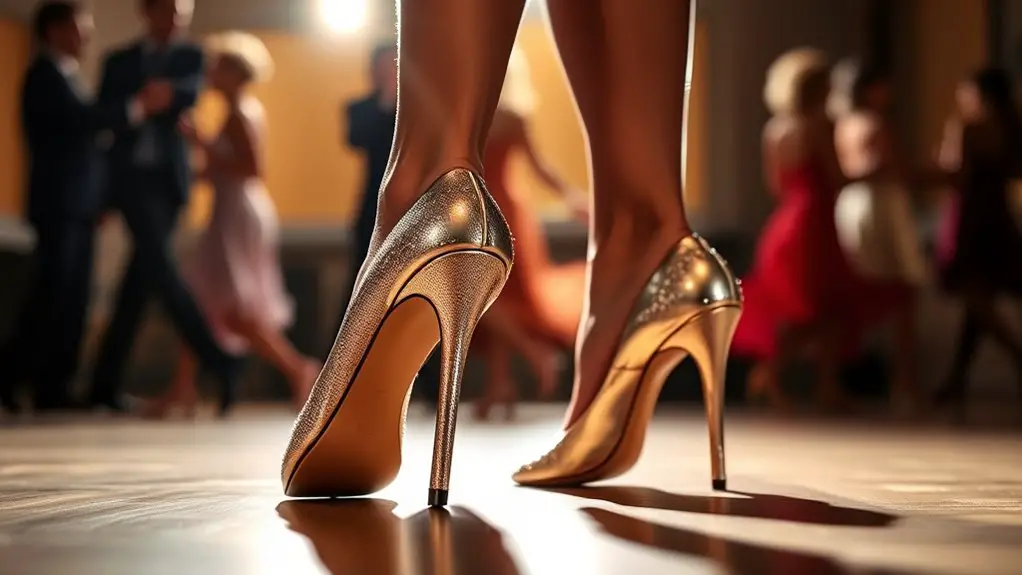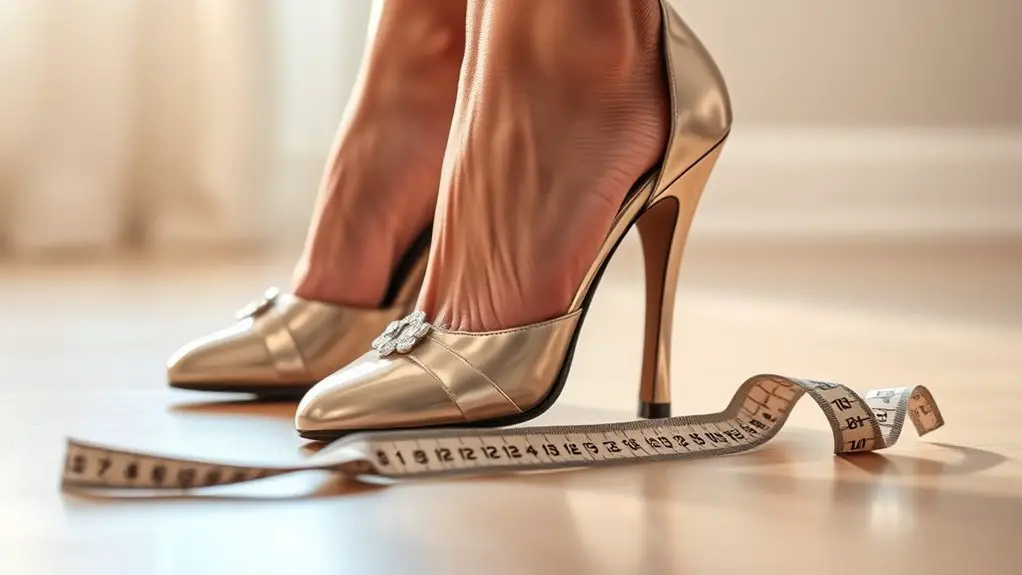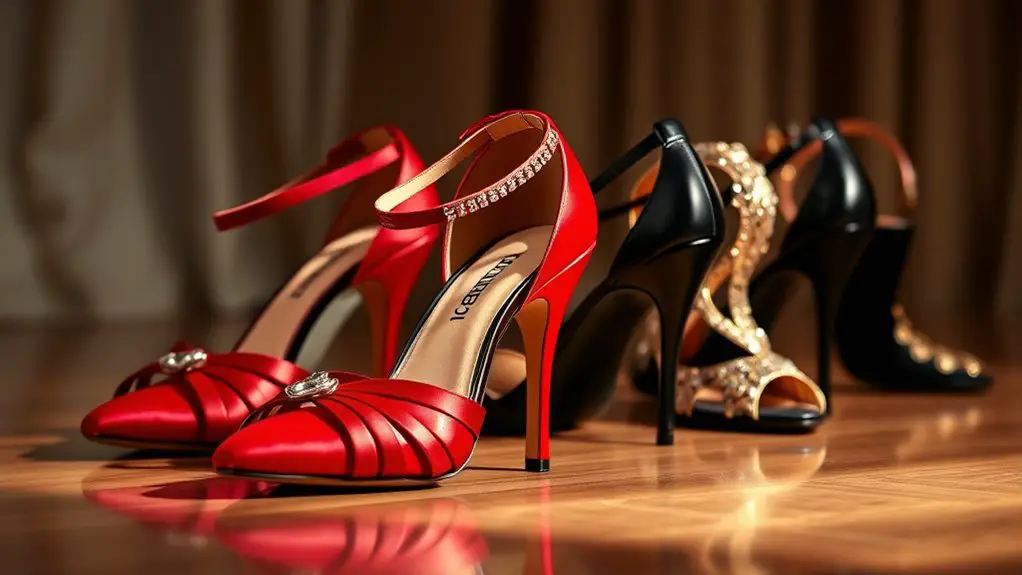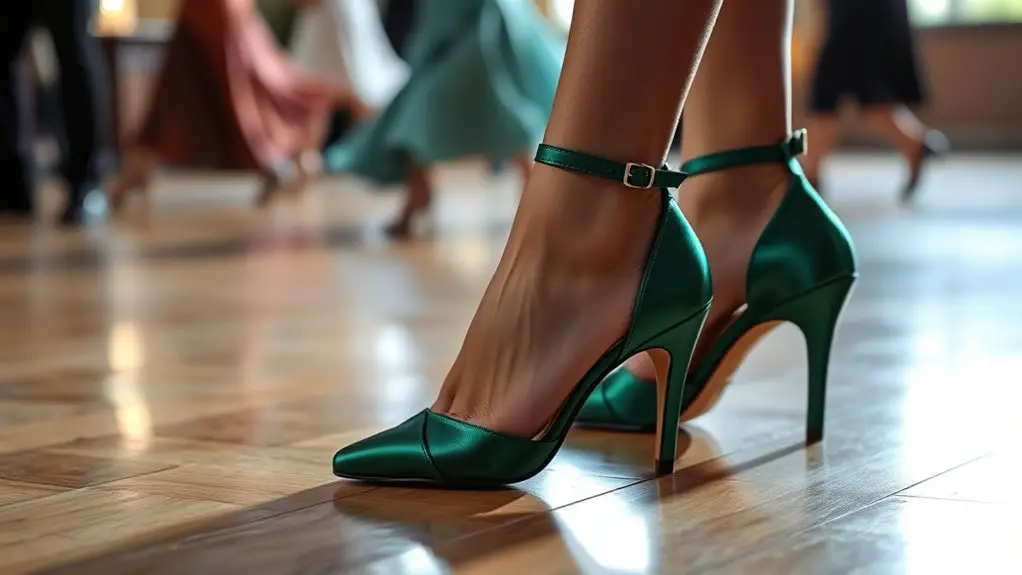For the best heels in ballroom dancing, look for a moderate height of 2.5 to 3 inches. This range enhances your turns while ensuring stability. Opt for materials like leather for comfort and durability, or choose satin for a sleeker look. Make sure your heels fit snugly with adequate arch support to keep you dancing effortlessly. Different styles serve various dance genres, so picking the right pair is essential. There’s so much more to discover about making the perfect selection!
Understanding Heel Height and Its Impact on Performance

When you step onto the dance floor, the heel height of your shoes can greatly influence your performance. The right heel height can enhance your performance balance, allowing for smoother movements and more fluid shifts. If your heels are too high, you might struggle with stability, making it difficult to execute turns and spins with grace. Conversely, lower heels can provide a solid foundation, but they may limit your ability to achieve the desired lines and postures.
As you explore different heights, consider how they affect your weight distribution and foot alignment. A moderate heel, typically around 2.5 to 3 inches, often strikes the perfect balance, offering both elegance and practicality. You’ll find that this sweet spot helps you maintain poise while facilitating easier footwork. Ultimately, understanding heel height effects is essential for maximizing your performance and truly shining on the dance floor.
Choosing the Right Material for Comfort and Durability
Selecting the right materials for your ballroom dancing heels greatly impacts both comfort and durability. The material types you choose can greatly influence how your feet feel during those long hours on the dance floor.
| Material Type | Comfort Level |
|---|---|
| Leather | High |
| Satin | Moderate |
| Suede | High |
| Synthetic | Varies |
| Canvas | Moderate |
Leather offers exceptional durability while providing a snug fit, ensuring comfort levels remain high. Satin, while visually appealing, may not deliver the same support, so consider your dancing style. Suede allows for smooth movements but may require more maintenance. Synthetic materials can be lighter but often sacrifice comfort for durability. Canvas is breathable but might not withstand intense dancing sessions. By understanding these material types, you can make an informed decision that enhances your ballroom experience.
The Importance of Proper Fit in Ballroom Heels

When it comes to choosing ballroom heels, proper fit is non-negotiable for your comfort and support on the dance floor. The right heel height not only impacts your posture but also affects your ability to perform fluid movements, while ensuring your shoes match your foot shape can make all the difference in how you feel while dancing. Prioritizing fit will elevate your experience, allowing you to focus on the rhythm rather than discomfort.
Comfort and Support
Although many dancers are drawn to the allure of stunning ballroom heels, the importance of comfort and support cannot be overstated. When you’re dancing for hours, you need shoes that not only look good but also feel good.
Here’s what to take into account for ideal comfort:
- Arch Support: A well-structured arch can prevent fatigue and discomfort.
- Cushioning Technology: Look for shoes that incorporate modern cushioning to absorb impact.
- Proper Fit: Ensuring the right size minimizes blisters and soreness.
- Breathable Materials: Choose materials that allow your feet to breathe during long sessions.
Heel Height Considerations
Finding the right heel height can make all the difference in your ballroom dancing experience. When you choose heels that offer ideal heel stability, you’ll feel more grounded and confident on the dance floor. Taller heels can enhance your line and posture, adding to the overall heel aesthetics, but they can also compromise your balance if you’re not accustomed to them. Striking the perfect balance between height and stability is essential; too high can lead to discomfort and instability, while too low might not give you the visual appeal you desire. Experiment with different heights to find what suits your dancing style and personal comfort. Remember, the right heel height not only elevates your look but also boosts your performance.
Foot Shape Compatibility
Many dancers underestimate the significance of foot shape compatibility when selecting ballroom heels. A proper fit can enhance your performance and comfort, making foot shape analysis essential. With diverse shapes and sizes, knowing your foot type helps you choose the right heel.
Consider these factors when selecting your heels:
- Width: Make sure the heel accommodates your foot’s width to avoid pinching.
- Arch: Different arches require specific support for best balance.
- Toe Box: A spacious toe box allows for movement and comfort during extended wear.
- Dancer Preferences: Personal comfort and style are key in making the right choice.
Top Brands for Quality Ballroom Dance Heels

When it comes to choosing the best heels for ballroom dancing, several top brands stand out for their quality and craftsmanship. You’ll find that brands like Capezio, Bloch, and Freed of London consistently receive rave quality reviews for their stylish designs and comfortable fits. Each brand offers unique features, making brand comparisons essential for selecting the right pair. Capezio is renowned for its innovative materials, providing durability without compromising flexibility, while Bloch focuses on ergonomic designs tailored for dancers. Freed of London, with its rich heritage, crafts heels that balance tradition and modernity perfectly.
These brands not only prioritize aesthetics but also guarantee that every heel supports your performance on the dance floor. Investing in a reputable brand means you’re choosing quality and reliability, essential for both practice and competition. So take your time, explore your options, and find the perfect heels that elevate your dancing experience!
Exploring Different Styles of Ballroom Heels
With the right brand in mind, you can now explore the various styles of ballroom heels that cater to different dance forms and personal preferences. Understanding ballroom heel styles can elevate your performance and confidence on the dance floor. Here are some popular designs and current heel design trends to contemplate:
- Standard Heels: Typically 2.5 to 3 inches high, perfect for smooth dances like waltz and tango.
- Latin Heels: Usually 1.5 to 2.5 inches, these are designed for Latin dances, offering flexibility and flair.
- Character Heels: Often lower and broader, ideal for theatrical performances or styles requiring more grounded movement.
- Customizable Heels: Increasingly popular, these allow you to mix and match colors and materials to fit your personality and dance style.
Choosing the right ballroom heel style can enhance your comfort and grace, making every step count!
Tips for Breaking in Your New Dance Heels
Breaking in your new dance heels can feel challenging, yet it’s an essential step toward achieving both comfort and confidence on the floor. Start with gentle breaking techniques, like wearing your heels around the house for short periods. This allows your feet to gradually adjust without overwhelming discomfort. When you practice, focus on your dance flexibility; try gentle stretches to ease any tension in your feet and calves.
Consider using a leather conditioner on the exterior to soften the material, making it more pliable. Also, wearing thick socks while dancing can help stretch your heels in a controlled manner. Remember to listen to your body; if you experience pain, give yourself a break.
Maintenance and Care for Your Ballroom Heels
Although it might seem tempting to toss your ballroom heels aside after a long night of dancing, proper maintenance is essential for preserving their beauty and functionality. Treat your heels with care, and they’ll serve you well on the dance floor for years to come. Here are some effective cleaning techniques and storage tips:
- Wipe after use: Gently clean your heels with a soft cloth to remove dirt and sweat.
- Rotate your pairs: Avoid wearing the same pair every time; this helps them maintain their shape and structure.
- Use shoe bags: Store your heels in breathable bags to protect them from dust and scratches.
- Check for wear: Regularly inspect the soles and heels for signs of damage, and repair them promptly.
Recommended Heel Types for Different Dance Styles
When you step onto the dance floor, the right heel can make all the difference in your performance and comfort, especially since each dance style demands specific features. Choosing the correct heel type is essential for expressing the nuances of Latin and Standard dances.
| Dance Style | Recommended Heel Type |
|---|---|
| Latin | Latin Heels (2.5-3 inches) |
| Standard | Standard Heels (1.5-2.5 inches) |
| Salsa | Flexible Latin Heels |
| Waltz | Sturdy Standard Heels |
Latin heels are typically higher and angled, allowing for sharper turns and heightened expression. In contrast, standard heels are lower, offering stability and support for smooth, flowing movements. Understanding these distinctions helps you select the perfect heel for your dance journey. With the right footwear, you’ll feel more confident and connected to the rhythm, elevating your performance.
How to Select Heels for Competitions vs. Social Dancing
How do you choose the right heels for competitions versus social dancing? The key lies in understanding the different demands of each setting. For competitions, your heel selection should align with your competition strategy, prioritizing style and performance. In contrast, social dancing requires comfort and versatility to navigate the social atmosphere. Here are some tips to guide your choice:
- Heel Height: Opt for higher heels in competitions for elegance, while lower heels work better for social dancing.
- Material: Choose sturdy, supportive materials for competitions; softer materials are ideal for casual settings.
- Fit and Comfort: Guarantee a snug fit for competitions to enhance performance; for social dancing, consider a more forgiving fit.
- Design: Go for flashy designs for competitions to catch the judges’ eyes, while subtle styles suit social events.
Ultimately, knowing the event’s vibe will help you select the perfect heels!
Frequently Asked Questions
How Often Should I Replace My Ballroom Dance Heels?
You might think you can keep your heels forever, but their lifespan varies. Regular maintenance can help, but it’s wise to replace them every 6-12 months, ensuring ideal support and performance during your dance routines.
Can I Wear My Dance Heels Outside?
You shouldn’t wear your dance heels outside. They’re designed for dance floor durability, and outdoor surfaces can damage them. For the best performance and longevity, stick to indoor settings where they truly shine during your routines.
Are There Specific Heel Types for Beginners?
You might think any heel works, but for beginners, specific heel types matter. Opt for 1 to 2-inch heels; they provide stability while you learn. Comfort’s key, so choose wisely for your dance journey!
What’s the Best Way to Store My Dance Heels?
To store your dance heels, consider using heel protection covers and dedicated storage solutions like boxes or bags. This keeps them safe from damage and dust, ensuring they’re always ready for your next dance session!
Can I Customize My Ballroom Dance Heels?
You can customize your ballroom dance heels with various custom heel options, reflecting your style. Staying updated on heel design trends guarantees your shoes not only fit perfectly but also stand out on the dance floor.



